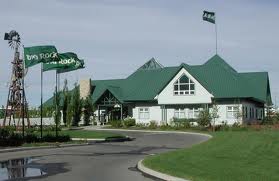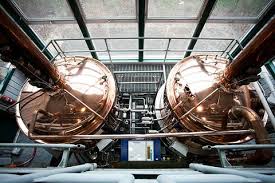 So, I think I admitted earlier I spent much of last week in Calgary. While I was there for non-beer reasons, I found some time to do a bit of beer-related work. As a result there will be a few posts in the coming days related to the trip.
So, I think I admitted earlier I spent much of last week in Calgary. While I was there for non-beer reasons, I found some time to do a bit of beer-related work. As a result there will be a few posts in the coming days related to the trip.
Today (Friday, March 14) on my CBC column I will be discussing Big Rock. The column arises out of a visit with Big Rock’s CEO Bob Sartor and Brewmaster Paul Gautreau. The three of us sat down to discuss Big Rock’s new strategic direction, what is behind it and where they see Big Rock going in the future.
Big Rock, of course, is one of Canada’s oldest craft breweries, opening mere months after Granville Island. For many people my age, Traditional Ale was their first experience of beer “with flavour”. Through the 1990s, Big Rock grew rapidly, becoming one of the larger breweries in the country with distribution across the nation and ambitions to push into the States.
All of that focus on growth came at a price. Over the past decade or so, Big Rock’s reputation as a craft brewer was badly tarnished – search the comments on my site and you will find many examples of dismissive, disappointed craft beer fans. In my opinion, the damage was mostly self-inflicted. The release of pale lager after pale lager (Gopher, XO, Kold, etc.) jumping on every latest big boy beer craze (low-carb beer, lime beer, etc.), the shelving or downplaying of their more “craft-y” brands (Magpie, McNally’s Extra, etc.) and the willingness to produce sub-standard house beer for pubs and discount beer at reduced prices left the indelible impression of a brewery going down the corporate path.
 In the past year or so, Big Rock has shown a very different face. They have launched two new series: Brewmaster’s Edition and the Alchemist Series. The former offers traditional craft styles and the latter is more experimental. But in addition, they are throwing out a whole gamut of one-offs, ranging from steinbier to gruit to spiced beer of every description. Last year they put out more than two dozen different one-offs, and this year plan another 27. You could argue this is overkill – that maybe they are trying TOO hard to impress. But given from how far back they are starting, maybe they do need this level of overdrive for awhile.
In the past year or so, Big Rock has shown a very different face. They have launched two new series: Brewmaster’s Edition and the Alchemist Series. The former offers traditional craft styles and the latter is more experimental. But in addition, they are throwing out a whole gamut of one-offs, ranging from steinbier to gruit to spiced beer of every description. Last year they put out more than two dozen different one-offs, and this year plan another 27. You could argue this is overkill – that maybe they are trying TOO hard to impress. But given from how far back they are starting, maybe they do need this level of overdrive for awhile.
The CBC piece will talk more about the business end of things, how Sartor has re-designed the business model for Big Rock, aiming for smaller, more nimble and more focused on connecting with community. Here I want to talk about more beer-y things.
First, is the brewery. We, of course, started our visit with a tour. The brewery is a stark embodiment of Big Rock’s central dilemma. The building is dominated by a huge (by craft standards) 200 hectolitre (hL) brewhouse. The thing is massive. You have to move a lot of beer to make having a system that size worthwhile. Over to one side, dwarfed by the towering tanks of the main system, is the 20-hL Kasper Schultz system. This is the source of most of the new seasonals and one-offs. But to my surprise there was a THIRD brew system in the building. Tucked in a small corner was a tiny 3-hL system. Barely bigger than my homebrew set up (well, okay still a fair bit larger, my system is .4-hL), it looked almost like a miniature model of a brewery. I thought it was just a pilot brewery (and it does fulfill that function, too) but I was told its main purpose is to brew small batch one-offs tailored to restaurants or bars. A pub can work with Gautreau to design a beer specifically for their pub. Since it produces only about six full size kegs, it is easy to play around with ingredients and the like.
I was intrigued by this arrangement. They have the muscle of a big brewer but have found a way to insert a high degree of flexibility into their set-up. Hence 27 beer a year! In talking with Gautreau I could sense he is enjoying his new found freedom to be creative. No one is saying no to even his most outlandish ideas.
Second, Big Rock is opening two new brewery operations, one just announced in Vancouver and another coming soon in Toronto. From their description, these are not just breweries, but are going to be anchored around drawing people into the locations, much like a grander version of a brewpub. The B.C. brewery is 25-hL, so traditional craft size with the intention of producing beer unique to that location (as well as supply the keg market for main brands). This move seems highly similar to Molson-Coors’ Beer Academy (see my review of it here) in Toronto, but it still an interesting departure.
Third is the beer itself. There is no question Big Rock is playing a different game when it comes to beer. Trad and Grasshopper remain its workhorses, but most craft breweries in Canada have the bills paid by their less adventurous beer. But there is no denying the boldness of their one-off attempts. Many say they are unimpressed with the quality of the one-offs, but the significance is in the effort in my opinion. In a way they are playing a bit of a high risk game. It is easy for Alley Kat or Half Pints or Dieu Du Ciel to toss out a variety of experimental beer, even if some don’t work quite the way they hoped, because they can fall back on their overall reputation. Big Rock is trying to rebuild its reputation through the use of these one-offs, and that is a bit more of a high wire act in my opinion.
My take on the one-time releases so far is that they have been uneven. Some, such as the Saaz (which is now a permanent addition) were well executed and very enjoyable, some, like the Erratic, have been fascinating and others certainly worth the effort. There have been a few disappointments in the mix too, but, really, with two dozen releases, who is going to like every one? My overall critique, if I were to offer one, is that the base beer for the experiments seem too clean and too pristine and don’t give me enough to balance the other flavourings.
I have been talking about Big Rock to lots of beer consumers over the past year, gauging the reaction to the transformation. There is still a high degree of skepticism, which is fair, but there is widespread recognition that there is something different going on, and it is better than what was going on before. Eighteen months into Sartor’s leadership I have become convinced that Big Rock’s intentions are real. It wants to re-make itself and re-establish its craft credentials. That is a process that takes time. Big Rock as a new generation craft brewer is a work in progress.
I think the goal for beer consumers now is to switch from dismissing Big Rock to offering constructive criticism. Tell them what you think of the beer, how it can be improved and what you want to see from them in the future. Even if your evaluation is highly critical, I have a sneaking suspicion they might actually listen.



March 16, 2014 at 4:06 PM
So did you get any insight into whether the core brands have been re formulated to boost their flavour a bit or is that too proprietary?
March 18, 2014 at 2:30 PM
Owen, my sense is that the core brands will stand pat for the time being. I think they are more interested in seeing what they can add to the line-up (a la Saaz Pilsner) rather than mess with the cash cows.
March 17, 2014 at 9:58 AM
For me it seems like you mention that the base beer for the experiments is not only too clean but also to caramel-like and sweet. I think they should play around with other yeast strains as well. They all taste like they are using the same house yeast so its hard for each beer to stand out?